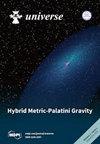On the Nature of the Radio Calibrator and Gamma-Ray Emitting NLS1 Galaxy 3C 286 and Its Multiwavelength Variability
IF 2.5
4区 物理与天体物理
Q2 ASTRONOMY & ASTROPHYSICS
引用次数: 0
Abstract
The quasar 3C 286, a well-known calibrator source in radio astronomy, was found to exhibit exceptional multiwavelength properties. Its rich and complex optical emission-line spectrum revealed its narrow-line Seyfert 1 (NLS1) nature. Given its strong radio emission, this makes 3C 286 one of the radio-loudest NLS1 galaxies known to date. 3C 286 is also one of very few known compact steep-spectrum (CSS) sources detected in the gamma-ray regime. Observations in the X-ray regime, rarely carried out so far, revealed evidence for variability, raising the question whether it is driven by the accretion disk or jet. 3C 286 is also well known for its damped Lyman alpha system from an intervening absorber at z = 0.692, triggering a search for the corresponding X-ray absorption along the line-of-sight. Here, we present new observations in the radio, X-ray, optical, and UV bands. The nature of the X-ray variability is addressed. Spectral evidence suggests that it is primarily driven by the accretion disk (not the jet), and the X-ray spectrum is well fit by a powerlaw plus soft excess model. The radio flux density and polarization remain constant at the Effelsberg telescope resolution, reconfirming the use of 3C 286 as radio calibrator. The amount of reddening/absorption along the line-of-sight intrinsic to 3C 286 is rigorously assessed. None is found, validating the derivation of a high Eddington ratio (L/LEdd∼ 1) and of the very high radio-loudness index of 3C 286. Based on the first deep Chandra image of 3C 286, tentative evidence for hard X-ray emission from the SW radio lobe is reported. A large variety of models for the gamma-ray emission of 3C 286 are briefly discussed.论射电校准器和伽马射线发射 NLS1 星系 3C 286 的性质及其多波长变异性
类星体 3C 286 是射电天文学中一个著名的校准源,它被发现具有特殊的多波长特性。其丰富而复杂的光学发射线光谱揭示了其窄线 Seyfert 1(NLS1)的性质。鉴于其强烈的射电发射,这使得 3C 286 成为迄今所知射电最响亮的 NLS1 星系之一。3C 286也是极少数在伽马射线波段探测到的紧凑陡谱(CSS)源之一。迄今为止很少进行的X射线观测发现了变异的证据,这就提出了变异是由吸积盘还是喷流驱动的问题。3C 286还因其在z = 0.692处来自于一个介入吸收体的阻尼莱曼α系统而闻名,这引发了人们沿着视线寻找相应的X射线吸收。在这里,我们展示了在射电、X 射线、光学和紫外波段的新观测结果。我们探讨了 X 射线可变性的性质。光谱证据表明,它主要是由吸积盘(而不是喷流)驱动的,X 射线光谱与幂律加软过量模型拟合得很好。在埃菲尔斯贝格望远镜的分辨率下,射电通量密度和偏振保持不变,再次证实了使用 3C 286 作为射电校准器的观点。对 3C 286 固有的沿视线变红/吸收量进行了严格评估。没有发现任何红化/吸收,这验证了3C 286的高爱丁顿比(L/LEdd∼ 1)和极高的射电响度指数的推导。根据 3C 286 的第一张钱德拉深度图像,报告了西南射电叶发射硬 X 射线的初步证据。简要讨论了3C 286伽马射线发射的各种模型。
本文章由计算机程序翻译,如有差异,请以英文原文为准。
求助全文
约1分钟内获得全文
求助全文
来源期刊

Universe
Physics and Astronomy-General Physics and Astronomy
CiteScore
4.30
自引率
17.20%
发文量
562
审稿时长
24.38 days
期刊介绍:
Universe (ISSN 2218-1997) is an international peer-reviewed open access journal focused on fundamental principles in physics. It publishes reviews, research papers, communications, conference reports and short notes. Our aim is to encourage scientists to publish their research results in as much detail as possible. There is no restriction on the length of the papers.
 求助内容:
求助内容: 应助结果提醒方式:
应助结果提醒方式:


